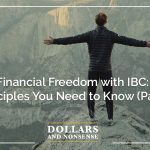In this episode, Nate continues the discussion of the six financial principles that serve as the bedrock of the Infinite Banking Concept. In other words, understanding the principles is fundamental to finding a solution based on financial realities and becoming your own banker.
Topics Discussed:
- Finance everything you buy
- Banking is inescapable no matter how you do it
- Capital attracts opportunities like a magnet
- How people succeed best when they implement the full process
- Why Mutual Insurance is the best for IBC banking system owners
- Contrasting IBC with conventional retirement planning structure
- Mutual Insurance Companies provide the best way to “plug in” to the banking system as owners.
- Safe capital creates an Antifragile financial position
- Why the power of IBC cannot fully be shown on a page of numbers
Episode Resources:
- Gain access to our Beginner’s Course now FREE to listeners of the podcast here now
- What is Infinite Banking
- Who was Nelson Nash?
- CREDIT: Episode art background photo by Peter Conlan
Podcast transcript for episode 172: 6 Principles of Infinite Banking II
Nate: In this episode, I continue the discussion with part two of the six financial principles that serve as the bedrock of the Infinite Banking Concept. This is Dollars and Nonsense. If you follow the herd, you will be slaughtered.
All right, everyone, welcome back to the show. We’re going to pick up really right where we left off in the last episode where I described the first three core principles that the entire Infinite Banking Concept is based on. And I’m going to finish up today with the last three. But to frame the discussion once again, just very, very quickly, I believe that the Infinite Banking Concept is based on a set of principles or ideas, and that those core principles point you in the direction of using dividend paying whole life insurance as a banking solution. I think this is fundamental to understanding it and that once you understand those principles that exist or these realities in the financial world and you’re wanting to try to find a solution based on those, you will, just like Nelson Nash did in the 1980s, you will settle on, man, dividend paying whole life insurance policies, offer the best solution to become your own banker.
Notice what I didn’t say though. What I didn’t say was that the numbers on a life insurance policy illustration point you in the direction of using that policy as a banking solution. I’m serious about this, that I think oftentimes people get involved in this system and they will either choose to do it or not to do it based on the numbers on a life insurance policy illustration, and that is the driving force. I believe it’s extremely important, I really do. I’m just merely saying that Infinite Banking can’t be proven by that. Infinite bank or the policy is simply the solution that the principles that Nelson Nash teaches point you to. And I love that about it. I love the numbers. I really do. But what I’m saying is I think that’s a bit of a mistake when trying to determine whether IBC as a strategy is something you want to implement.
So think about it. I’m going to do a quick review of last week. So the idea is this. There is a truth. Number one, the first principle was that you finance everything that you buy. So because it is true that you finance everything that you buy, you either pay interest to a bank to use their money or you use your own cash to purchase something, in which case you lose any interest that money could have earned. Maybe you should orient your financial life with that being at the forefront. That will filter into decisions that you make.
Number two, the idea that banking is inescapable. That’s the second core principle that banking is, you are required to be in banking until the day that you die. We likened this last week to the fact that you are not required to be in the stock market until the day you die. You can choose to be in. You can choose to sell out, you can choose to do whatever you want, anytime you want, but you have to be in banking until the day that you die. You can’t escape it.
Number three, that people succeed when they implement a process or a strategy that in every area of life when people are given a framework to work from, they often are more successful than when they have zero process, zero strategy, no framework, and they’re just kind of hoping that whatever they’re doing is going to work out in the end. Let’s keep going. Let’s pick up with new content today. We’re going to dive into the fourth core principle of IBC that I believe should be understood before you even dive into the numbers, before you even ask to see a policy illustration. These should be understood.
So number four, the idea or the concept, the principle that capital attracts opportunities or that capital allows you to take advantage of opportunities. And this stands in contrast somewhat to the conventional retirement planning structure that exists, which is essentially Wall Street governments and so forth creating solutions for you to store capital up that you have essentially no control over the success or failure of those pools of capital. We’re all really taught to separate ourselves from money to invest it in these places, especially like retirement programs that are really designed to hold money for a long period of time and to penalize you for tapping into.
So the idea is that you are separating your capital and you’re placing it in a place that’s kind of capital prison of sorts. And when you operate out of this framework, there may be really great investment opportunities, business opportunities in life that you will never even consider and you certainly won’t be looking for because of where your capital is being built up. And so Nelson Nash describes this in his book too. We tried to mention this as well many times that some of the power of IBC can’t fully be shown just on numbers on a page every time because your life can look different when you are building up a capital pool inside of a policy that’s fully accessible at any time and constantly growing with no risk of loss. This puts you in a very powerful position to take advantage of other opportunities.
Announcer: Is the money in your bank account losing value instead of growing? Are inflation and taxes going to get better or worse? Conventional banking makes the bank rich using your money and pays you little to nothing in return. We believe in challenging the status quo. After all, most of those conventional tools only seem to make someone else rich. Let us show you how to beat the banks and inflation. Visit livingwealth.com/beatinflation. You’ll receive instant access to what we call the beginners course. This in-depth and easy to follow course teaches people how to create and profit from Infinite Banking. You can become debt-free, in control and achieve financial security and significance. Stop letting the banks and Wall Street dictate your financial future. Go to livingwealth.com/beatinflation today to instantly receive free no obligation access to this priceless course on Infinite Banking. Again, that’s livingwealth.com/beatinflation. Now back to Nate and Holly.
Nate: The fifth principle is that mutual insurance companies, mutual life insurance companies function in the same business model as banks with different ownership and with different parties receiving the profit of the business. This is a fundamental idea that points you to realizing that dividend bank life insurance based on reality can be a great banking solution. This is one of the most important ones. And so the idea that mutual life insurance companies and banks are in the same business operating in very similar ways. They take other people’s money, life insurance companies in the form of premiums, banks in the form of deposits. They lend that money out to other people, and those people pay interest to the bank. They pay interest to the insurance company. Then the insurance company pays their depositors, the bank pays their depositors’ interest and whatever is left over is sent as a dividend to whoever owns the institution.
In a bank, all of the business is built on creating profit for the owners of the bank. So some businesses choose to not send out cash dividends or not very much in cash dividends, and instead choose to take the profit, the operating profit and reinvest it to expand the business, which will then boost share prices. So shareholders may say, “I don’t want a dividend. I want my share prices to go up.” That’s all great. But what we’re saying is nonetheless, the bank or the insurance company is in business to profit the owners. That’s the way business works in capitalism. That’s the way it works. And so this is the idea. This is the concept. This is the core function. So the idea is that a bank over a period of time never pays their depositors a greater amount of interest than the mutual insurance companies are going to be able to pay to their policy holders because the bank is making money off of its depositors. Interest may go up and down over time, but they’re always keeping a large spread above what they’re paying their depositors.
In the mutual insurance company world, the spread also goes back to the policy holders. So the principles answer some of these questions. Why is it likely that owning a policy with a dividend paying whole life insurance company is going to produce a more profitable environment for me over my lifetime than simply being a depositor at a bank? It is based on this idea. It is based on this principle. And if that doesn’t make sense, then there’s nothing else I can do. Numbers on the page can only go so far to understand this principle.
Last thing on this point, then we’re going to finish up with number six. Last one on this point, Nelson Nash also did an amazing job with a metaphor that I think does not get brought up enough. And the metaphor is the idea of co-generation. So remember, the metaphor he was using was that if you take for an example, a sawmill. And so you have a lumber mill, a sawmill who is cutting lumber all day, and there’s a ton of saw dust that’s being created that doesn’t have much of an economical purpose in reality. You can’t do much with saw dust. You can do some, but you can’t do a ton with sawdust, and they’re going to have a lot of it.
So as Nelson Nash describes, it’s not unusual for these large mills to have their own electrical generator that powers the plant because they can take this otherwise not that useful, saw dust and burn it to create power to power the plant, to create electricity. And it’s also not uncommon for those generators to be able to produce more power than what is even needed to run the mill. Now, what are they going to do with all this excess power? If they wanted to make good use of it, they could attempt to go run their own power lines and knock on doors and try to tell people that they should be buying power from their sawmill as opposed to the electric company. But of course, that sounds ridiculous.
Instead, what you can do is plug into the system that’s already there, the power system that’s already there, and sell that excess power back to the power companies who will buy it. Essentially the idea is, instead of creating your own bank or instead of creating your own electrical power company, for most of us it makes sense to plug into one that already exists to become more profitable. You don’t have to go through a process of becoming your own banker by starting your own company, your own power company, your own banking company. I think that’s a really great model to understand. What we’re really trying to say is that we are just trying to plug into the banking business as an owner in the simplest, most scalable way possible. It would be difficult for all of us listening to this podcast to start our own banking enterprise by itself. But it’s not difficult to plug in to one that already exists that’s more profitable.
So number five, with mutual insurance companies function in the same business model as banks with different people profiting from the entire enterprise. That’s one of core percent of principles that point to us in the direction that this might be a good tool to use to practice banking with. And lastly, number six, this one is also a little bit less catchy, and I’ve got a few things to explain in it. But the six core principle that I think really points you to this idea is the idea of anti-fragility. That having non-volatile assets puts you in an anti-fragile financial position. And the idea of being anti-fragile means that you can gain from chaos, things that gain when disorder strikes. So volatile things are things that are destroyed like the stock market and different things where they’re fragile because they don’t like chaos. They like consistency. But the world is filled, history is filled with unanticipated random events that cause this order, which would then point us to look for a way that we can create what he would call some level of anti-fragility where our entire world is not destroyed when random, chaotic disorderly events strike.
And this is the idea of putting yourself in an anti-fragile position. The same thing goes from many different areas, like anytime that there’s volatility. That’s why I believe that a tax-free place also helps produce anti-fragility because in a world of deferred tax programs, the actual amount of money that you have in your account at the day that you’ll need it years down the road, you really don’t know what it’s going to be because the government and the elected officials can decide to change the tax rules, even just simply the income tax brackets we know change all the time. They change all the time, and we’re actually in a very low income tax bracket situation in the country today compared to what historically we have been in overall.
So if you practice this concept, you’re automatically going to start gaining levels of anti-fragility. And as opposed to when your entire world is built in volatile assets, you become very fragile. And we talk about this by the way, in our beginner’s course on Infinite Banking. It’s actually in the last episode. You can see the idea of anti-fragility or fragility being put to work with the idea of just retirement, as an example. So the idea of anti-fragile is this exact same thing that instead of having the money in the typical bond stock portfolios, instead you have some money there, but you also have money in a different bucket that is not fragile, that is not volatile, that is anti-fragile, that continues looking great, even it’s just a completely different bucket. It’s not a volatile bucket. It actually puts you in a position where you can take a higher amount of income without the risk of running out of money compared to if you only had one of them.
That’s the idea. So if you just had the safe place without the more volatile place, you’d be able to pull out X amount of money. If you just had the volatile place and not the safe place, you’d be able to pull out X amount of money. But if you had both of them mixed together at the same time, it puts you in a position to be able to pull out more income. This is just one idea of anti-fragility, by the way, that’s implemented with us.
So I hope this has been a fun ride during these last two episodes. It’s certainly a lot of information. If you have any questions, as always, feel free to email me, at nate@livingwealth.com. I’d be happy to answer them. Otherwise, we will see you next week. This has been Dollars and Nonsense. If you follow the herd, you will be slaughtered.
Announcer: One last thing before you go. Start your journey towards financial security and wealth today. Visit livingwealth.com/beatinflation. You’ll gain instant free access to the beginner’s course, Ray, Nate, and Holly made just for you. Again, that’s livingwealth.com/beatinflation.









